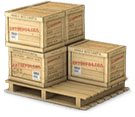If you are exporting to the EU or planning to export to the EU after 31 October 2019, there are some steps you need to take.
Check you have a UK EORI number
Make sure you have a UK EORI number with a GB prefix. If you are VAT registered, and currently trade exclusively with the EU, the UK Government should have automatically issued you a UK EORI number. However if you are below the VAT threshold (for the 2019/20 tax year, the VAT registration threshold is set at £85,000, but can change each year), and you trade exclusively with the EU, you will need to apply for a UK EORI number via the GOV.UK website.
Check the documentation you need
Shipments to the EU will be treated the same as existing non-EU shipments. Goods must be accompanied by a commercial invoice – you can view our template here.
Your goods may need an export license and/or additional documents and certification such as safety and security declarations. This may apply if you are exporting livestock or food or controlled goods.
Check
That the EU importer of your goods has an EU EORI number, obtained any relevant import certificates and completed an import declaration on their country’s import declaration system
Understand VAT
If the UK leaves the EU without an agreement, VAT registered UK businesses will continue to be able to zero-rate sales of goods to EU businesses but will not be required to complete EC sales lists. Those UK businesses exporting goods to EU businesses will need to retain evidence to prove that goods have left the UK, to support the zero-rating of the supply. The required evidence will be similar to that required for exports to non-EU countries with any differences to be communicated in due course.



